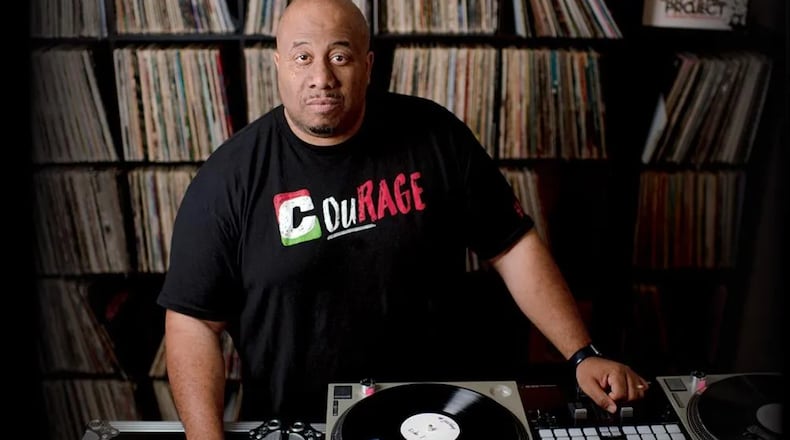“It took eight people to lift those shoes,” one of the museum guards told us as we headed to the upstairs galleries for the museum’s newest special exhibition.
“The Culture: Hip Hop and Contemporary Art in the 21st Century” is on view at the CAC (Cincinnati Art Museum) through Sept. 29. It’s fascinating, entertaining and lots of fun.
The giant sneakers reinforce an important point made by the show’s on-site curator, Jason Rawls, The Ohio State University’s first-ever assistant professor of Hip Hop.
“Grandmaster Caz said hip hop didn’t invent anything. Hip hop reinvented everything,’” Rawls said quoting American rapper, songwriter and DJ Curtis Brown, better known as Grandmaster Caz.
The show’s mission, Rawls explained, is to share with visitors the variety of ways in which the hip hop mentality uses the resources at hand in innovative ways. The huge athletic shoes in the downstairs entryway are a perfect case in point. “It’s about taking the resources that you have and creating what you need.”
How it began
Hip hop originated in the mid-1970s as a cultural expression of Black, Latinx, and Afro-Latinx youth. Call-and-response chants, followed by rap rhymes and lyrics overlaid on tracks, formed the foundations of the music. But Rawls said the biggest misconception about hip hop is that it’s just rap music.
“If you think of it that way you’re missing out on so much because there’s so much more to the culture,” he said. “That’s what graffiti and breakdancing and DJing add to the culture.”
As you make your way through the galleries, you’ll be introduced to all of those other hip hop elements. The exhibit focuses on six themes: Language, Brand, Adornment, Tribute, Pose, and Ascension. There’s art, graffiti, costumed mannequins, and videos. The multimedia exhibition showcases more than 90 works of art by some of today’s most important and celebrated artists such as Banksy, Jean-Michel Basquiat, Roberto Lugo, Carrie Mae Weems, Mark Bradford, William Cordova, Hassan Hajjaj and Hank Willis Thomas.
Fashion brands in the exhibit include Chanel, Gucci, Cross Colours, Vivienne Westwood and Virgil Abloh’s collections for Louis Vuitton. A range of music ephemera is also on display. You’ll listen to hip hop music, see clips from music videos, see Lil Kim’s wigs and a bucket hat worn by rapper Cardi B during a 2018 Grammy performance.
Trigger questions along the way aim at promoting discussion.
“I’m excited about this exhibit because it represents the culture of hip hop, not just the music,” said Rawls, who leads the team that’s creating a hip hop studies program in OSU’s School of Music and Department of African American & African Studies. Rawls — who is featured in a hip hop exhibit at the Smithsonian National Museum of American History — is also known for his music production work with artists like Mos Def, Talib Kweli, and Beastie Boys and is a published author and DJ (aka J. Rawls). Rawls also helped develop the first hip hop-based education program in a college of education at Ohio University.
When explaining hip hop to others, Rawls uses himself to demonstrate.
“When you’re walking down the street and you see somebody and they have their shoes laced a certain way or have their hat cocked to the side a certain way, you can tell that person’s hip hop. You can see how they’re dressed, how they wear their clothes, their style. It’s an outward sign of who we are.”
What about funk?
If you live in the Miami Valley you’re probably aware that in the 1970s and 1980s Dayton’s west side was well known for its stable of funk bands. Although there are some early albums and CDs in the Cincinnati exhibition, funk as a musical genre isn’t specifically represented.
But Rawls said funk is the basis of Hip Hop.
“Hip hop was born out of young people in the Bronx in the mid-1970s who did not have money for instruments or music lessons,” he explained. “Instead, they repurposed old Funk or disco records and manipulated them to fit their purposes.”
He said many funk songs have heavy drum beats.
“At a point in the song when the drums were playing with no other music, the young hip hop pioneers started calling this part the break or Break beat,” he said. “So they used the drum breaks from the funk records to create the palette for their parties. They innovated a new culture out of the resources they had available. Later on, hip hop, Funk music –, including many of the iconic Dayton groups – became the foundation for many classic hip hop records.”
Rawls said hip hop has become a cultural worldwide phenomenon. For the first time, breaking competitions have been added to the Summer Olympics and will take place August 9 -10 in Paris. It’s the first dance sport discipline to appear in Summer Olympic history.
Rawls said this Cincinnati exhibit is for everybody — any race, color, creed, religion.
“I’ve done shows in Iceland where there were no black faces in the crowd but they were rockin’,” he said. “We want people to come out and talk about this and ask questions. It’s for the whole community.”
How to go
What: “The Culture: Hip Hop and Contemporary Art in the 21st Century”
Where: Cincinnati Art Museum, 953 Eden Park Drive, Cincinnati
When: 11 a.m. to 5 p.m. Tuesday through Sunday; 11 a.m. to 8 p.m. Thursdays. Through Sept. 29.
Admission: Tickets are $12, with discounted rates for students, children and seniors. Free for members. TFree for nonmembers every Thursday evening from 5-8 p.m.
Visit cincinnatiartmuseum.org for the latest information.
Upcoming events
- CAM Kids Day: 11 a.m.–3 p.m., Aug. 3. A day filled with fun for the whole family. Enjoy scavenger hunts, preschool and docent-led activities, family-friendly performances and art-making stops. Free. Reservations not required.
- Gallery Talk Plus: 1–3 p.m., Aug. 10. Details to be announced. Tickets will be available on the museum’s website.
About the Author





